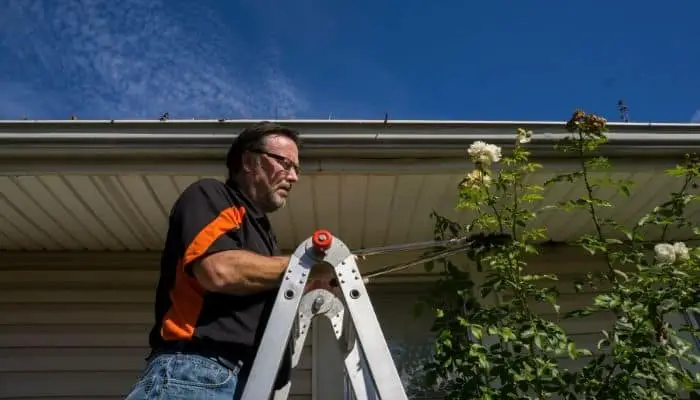If you grow roses, you’ll already know that it usually isn’t ideal for them to get too tall.
Roses are beautiful flowers that can look stunning in any garden, but they do need some time and attention to look amazing.
Table of Contents
Why Are My Roses Growing So Tall?

Your roses are growing tall because they aren’t receiving enough equal sunlight, or they haven’t been pruned recently enough.
Roses are fast-growing plants (especially when grown in fertile soil), and when they aren’t getting enough light they are encouraged to grow tall.
Plants get better light if they can outgrow their neighbors and get closer to the sun, so many plants will grow upwards as much as possible.
One of the things that prompt roses to grow tall is the lack of light low down.
If your roses are growing in the shade, they will keep trying to get their leaves up into the light, and this can cause them to become leggy.
Remove Shade When Possible
If you want your roses to grow bushier, they’ll need to be kept away from anything that casts a shadow over them.
If possible, remove plants or objects that are casting your roses in shadow, so you can encourage them to bush out at a good height instead of trying to climb.
If you can’t remove other plants, consider relocating your rose bush to a brighter spot.
It will not be happy or grow well if it can’t get enough light, so if it’s in shade for most of the day, think about moving it.
Related Article: Can A Rose Bush Survive Without Leaves? (All You Need To Know)
Prune Your Roses To Stop Them Growing Tall?
Roses will grow very tall if they are left without being pruned, and this doesn’t make for an attractive plant or a healthy plant (at least most of the time).
Roses grow to try and get more light on their leaves, but tall roses are vulnerable to strong winds, and may not have much space for new growth.
Pruning your roses will keep them bushy and to a good height in terms of both the aesthetic and the stability of the plant.
You can also remove deadwood that needs to be gotten rid of for the plant to produce new, healthy growth.
Pruning your rose increases air circulation and can reduce the chance of the plant suffering from rot or mildew, too.
Use this to your advantage and spend time shaping your rose and getting rid of any diseased or dead wood.
How To Prune Roses
So, you know what causes roses to grow, and why you need to prune them – so how do you do that?
Only Prune As Much As You Need To
If you live in an area where it doesn’t get too cold in winter and roses can grow almost year-round, you don’t need to prune them too harshly.
At the very most, try to only prune half of your rose bush.
Roses store food in their canes and when you prune too much of them away, it stresses them and affects their future growth.
If you live in an area that gets fairly harsh winters, you can prune a little heavier.
Just try not to cut the canes too close to the soil because your rose bush will need the reserves it keeps within them.
When To Prune
Roses should usually be pruned around late winter or early spring before they start growing for the new season.
This gives you a chance to cut out old growth before the new growth starts.
It is generally best not to cut roses near the end of their growing season, as they may start new growth, which could be vulnerable to frosts.
Wait until winter has passed before pruning.
Roses are hardy and will take hard pruning from time to time, but you should avoid cutting roses right to the ground unless dead or diseased wood makes this necessary.
Only Cut Your Rose Bush Back As Much As Necessary
Take your time when pruning and if you’re unsure, leave a little extra on your rosebush.
You can always prune more later.
But once it’s gone, it’s gone.
Cut stems at a 45-degree angle, just above an outward-facing bud.
Remove all dead wood and inward growing branches and cut off anything thin and spindly.
If you cut them back to the ground, they will need to use up energy stored in the roots, which can slow and weaken new growth.
Avoid pruning roses when they are in the middle of their growing season if possible.
Not only will you lose flowers and growth, but you might push the rose into an early dormancy period.
It will come back next spring, but this is better avoided.
Ideally, even if your roses are getting too tall, you shouldn’t cut them until they have finished growing for the year.
However, most roses are fairly hardy and are unlikely to be killed by pruning at the wrong time, or too severely.
When you finish pruning your rose bush, it should have the shape of a vase, narrower at the base with the canes rising and spreading out a little further.
If in doubt, do some research into your specific kind of rose and the best times to prune and techniques to use.
There are many rose varieties, so this may help you get the best possible results.
Different Types Of Roses Grow To Different Heights
There are many types of roses and some grow taller than others.
Bush Roses
Types of bush roses include hybrid tea roses and can grow to be between 2 and 6-ft in height.
Miniature Roses
If you’d like to grow beautiful rose bushes but are worried about them getting too tall, why not grow miniature roses.
Miniature roses are also a type of bush rose but they only grow to be about 6 to 24 inches tall.
Shrub Roses
Shrub roses, often used for hedges and ground cover, usually grow to be between 3 and 10 feet in height.
These types of roses include hybrid musk and wild roses.
Climbing Roses
Climbing roses (like ramblers) send out canes that can cling to walls and other surfaces.
These types of roses can grow to be up to 20 feet tall but rely on other structures for support.
There is a rose for almost every area of your garden so choosing the right one for your needs is important.
But if you’re looking for a pretty little rose bush that’s not going to grow too tall and troublesome, miniature roses are the way to go.
Summary
So, in answer to why your roses are so tall, it is either because they have not been pruned recently enough (or perhaps have been pruned too cautiously), or because low light levels are forcing them to grow tall.
Correct the low light levels if you can, and then prune your roses to a better height to promote bushy, lively, and healthy growth.




